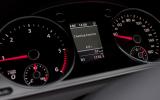The mileage of the Volkswagen CC on our long-term test fleet has fairly shot up in recent weeks, and a surprising number of those miles have been covered in neutral (or something approximating it).
That’s because the CC’s dual-clutch gearbox has a fuel-saving coasting function – a feature that’s found on an increasing number of DSG-equipped diesel-engined Volkswagens. It’s an interesting development (at least, it is to me), and one that’s worthy of some discussion. So here goes.
The coasting function declutches the engine when the throttle is lifted, which means that the car is free from the momentum-hungry shackles of engine braking (such as it is with a modern common-rail diesel) on the overrun. Now, before you write in and say that today’s engines have an overrun fuel cut-off which shuts off the fuel supply on a closed throttle, and that an engine coasting on tickover with the gearbox disengaged actually uses more fuel than one coasting in gear on a closed throttle, well, apparently it doesn’t.
In short, when you lift off you end up travelling much farther before you have to get back on it, and the subsequent fuel savings outweigh whatever is burnt on tickover while coasting. Touch the throttle or brake while coasting, or move the gear selector from D to its manual shift position, and the gear re-engages. The coasting function can also be disabled via the onboard menu settings, or overridden by keeping manual control over the gearchanges.
But coasting is bad, because you’re not fully in control of the car, right? Well, I’ve thought about this and I’m not so sure. If by ‘not in control’ you mean that the car slows less than you’re used to when you lift off, then perhaps so, but you quickly get used to managing the space in front of you to compensate. Broadly speaking, the rear wheels of a conventional front-wheel-drive car are no more corrupted by a loss of engine braking than the front wheels of a rear-drive car are, so what’s the problem?
It’s not perfect, though. When you get back on the throttle the engine rev-matches to road speed before engaging the clutch. At low speeds this is barely noticeable, but at 70mph the engine has to spin from 850rpm (tickover) to 2050rpm; at 80mph it has to get to 2350rpm, which can feel like forever. I’ve quickly learned when to knock the gear selector to its manual position to prevent the coasting function from kicking in when not wanted. Similarly, when pressing on along a twisting B-road, it’s best to give coasting a miss if you want to maximise your interaction with the car and the road.









Join the debate
Add your comment